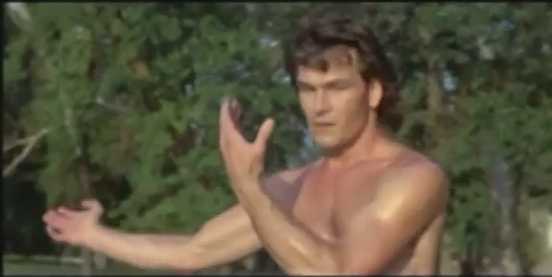This is what Americans think Taiji looks like. Or maybe I should say Tai Chi.1

Patrick Swayze doing Tai Chi in Road House.
Patrick Swayze is a wonderful dancer, and his Tai Chi (I refuse to use the term Taiji) looks like it. His energy is up high in his chest, his muscles are all taut and well defined, and his arms are moving completely separate from anything below his shoulders (and questionable about the shoulders). But I’d do him, if I swung that way.
Which is pretty much the point.
Coach Zeng Xiangbo2
[youtube https://www.youtube.com/watch?v=NUtGXqtdvLg]
I love this video. They start off with his basic movements. He is reasonably gentle with his partner. You see him repeatedly get the beginnings of an arm lock (or what could turn into an elbow break), but gives it up. He does a few uproots, but always holds onto his partner so he doesn’t hurt him.3 And every so often he will turn and look at the camera to see if everybody’s getting it (e.g. 1:28 into the video).
The seminar I attended with Coach Zeng was put together fairly quickly. He, unlike many teachers, uses push hands to teach Taiji to beginners. Some of the participants looked like they were beginners to the form, and probably had never done push hands before. Others, I can attest, had been doing it for years, and still needed help on the exercises.
The best part of his teaching, was his patience feedback on how I was doing. He took an exercise (constant bear?) that I had known about for decades, upgraded the skill level desired, and then gave moment feedback on what I was doing wrong, and stayed with it until I did it right.4 And he did this with everyone in the seminar on most of the exercises. He is much more into training than most teachers I have met.
Push hands is not fighting, but it is the iconic Taiji partner/relationship practice to develop fighting skills. And it was obvious that Coach Zeng had fighting skills if he needed them. One of his stories was that when he was teaching in Slovakia, he was working with “karate” (perhaps Systema) guys. Every time he would start to get in close they would have a fear reaction and jump away.
Coach Zeng isn’t the best at doing push hands that I’ve seen, but that still makes him a hell of a lot better than almost everybody I know. And he is the best that I know that is willing to work with beginners (well intermediate dilettantes) like me. And he has in spades what is lacking in American Taiji.
P.S. As far as I could tell he doesn’t speak a word of English, but his lovely assistant Gace did. Here he and Grace are doing a demo at Ohlone Park in Berkeley.
[youtube https://www.youtube.com/watch?v=JmmdqI1EMTc]
1. Somewhere between the time I first got interested in internal Chinese Martial Arts (CMA) and now, the world changed on how it romanized the Chinese language. It went from Wade-Giles, to Pinyin. This is how all my reference books referred to Peking, but I kept reading about this city Beijing in the news. So the martial arts I knew as Tai Chi became Taiji, Pa Kua became Bagua, and Hsing I became Xingyi. The advantage of Pinyin is that an untutored westerner will read it closer to how it’s actually pronounced. And in my case, closer is probably not all that close.

Coach Zeng Xiangbo
2. When I mentioned that the only videos of him that I could find on the web were from Slovakia, the organizer of the seminar said that Youtube had more if you put in his Chinese name. Since I’m illiterate in Chinese, that didn’t help me much. I did get his assistant to write it down for me.
And I found his facebook page (silly me, everyone has a facebook page now days). This is what I got: 曾祥柏.
3. In the seminar I asked him if he would do a large uproot and not hold onto me. He agreed, then grabbed me anyway because I was going to hit the video camera and person behind it.
4. If I read the itinerary right for the seminar we were going to that exercise, which is a thigh killer, at the beginning ot the two days. I think he looked at our group and decided to put it the end, rather than burn everyone out at the beginning.





